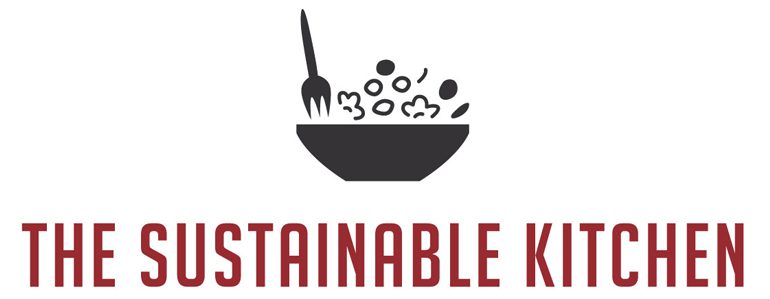If you’ve ever visited a pho noodle shop, you will most likely have seen banh mi on the menu, and wondering what the heck is a banh mi. Well, it’s a Vietnamese sandwich, but not just a sandwich. Really, nothing can compare to it. Bite into a banh mi, and you will get a flaky baguette, an umami aioli (bo), pickled vegetables like carrots and daikon, herbs, spices, peppers, and a protein like grilled meats or pate. Is your mouth watering yet?
My favorite place to get this was at Dong Phuong Bakery in New Orleans, LA. Their baguette is out of this world, with hundreds of people traveling from out of state to buy, bring home, and freeze. It’s a James Beard award-winning bakery for a reason. I’m still searching for a great banh mi place in Dallas, but sadly, nothing compares to Dong Phuong, so I’ve resorted to making my own with this Banh Mi recipe.
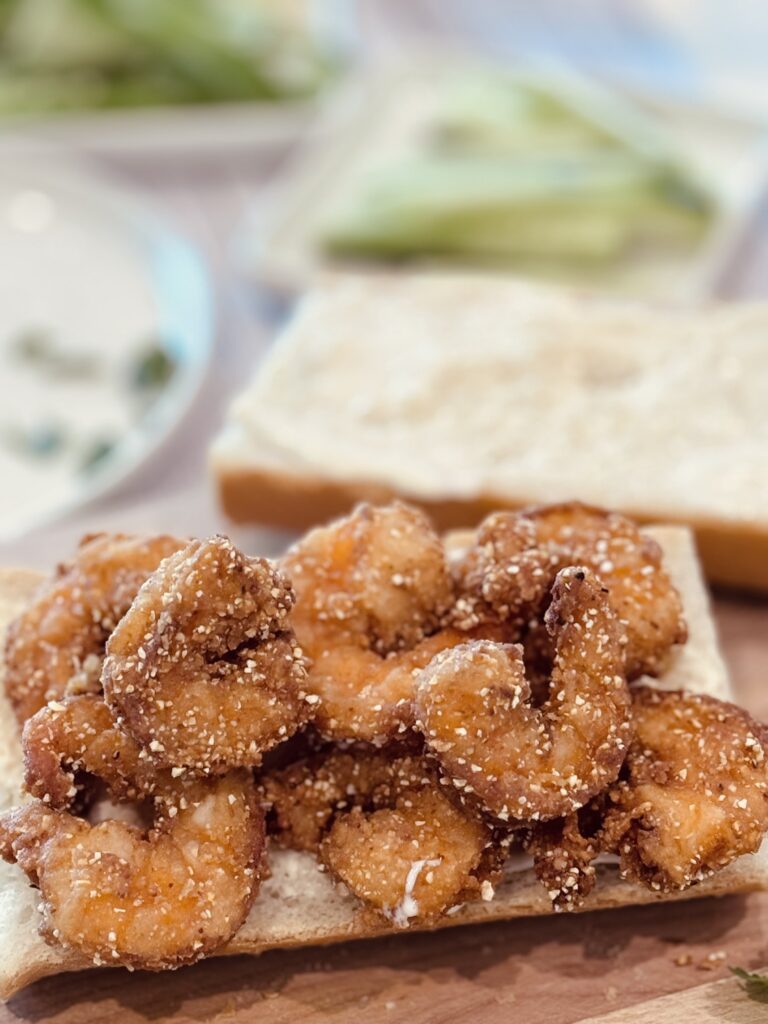
WHAT IS BANH MI?
Banh Mi is a Vietnamese signature sandwich made with a short baguette, usually with a crispy crust and soft, airy texture. It is highly personalizable and can be tailored to fit any dietary needs. It is split lengthwise and filled with meat such as Vietnamese ham, steamed pork roll, or pate. Vegetables such as sliced cucumbers, pickled carrots and daikons, cilantro or coriander, and jalapeno peppers are added. There is usually an aioli spread or bo in Vietnamese, which is made with egg yolks.
Depending on the protein, banh mi can be served hot or cold. For instance, you can add French cold cuts or liver pate as your protein. Whatever you choose, It’s an explosion of flavors and texture and has generated a cult following in the last years, evidenced by the banh mi shops popping up everywhere.
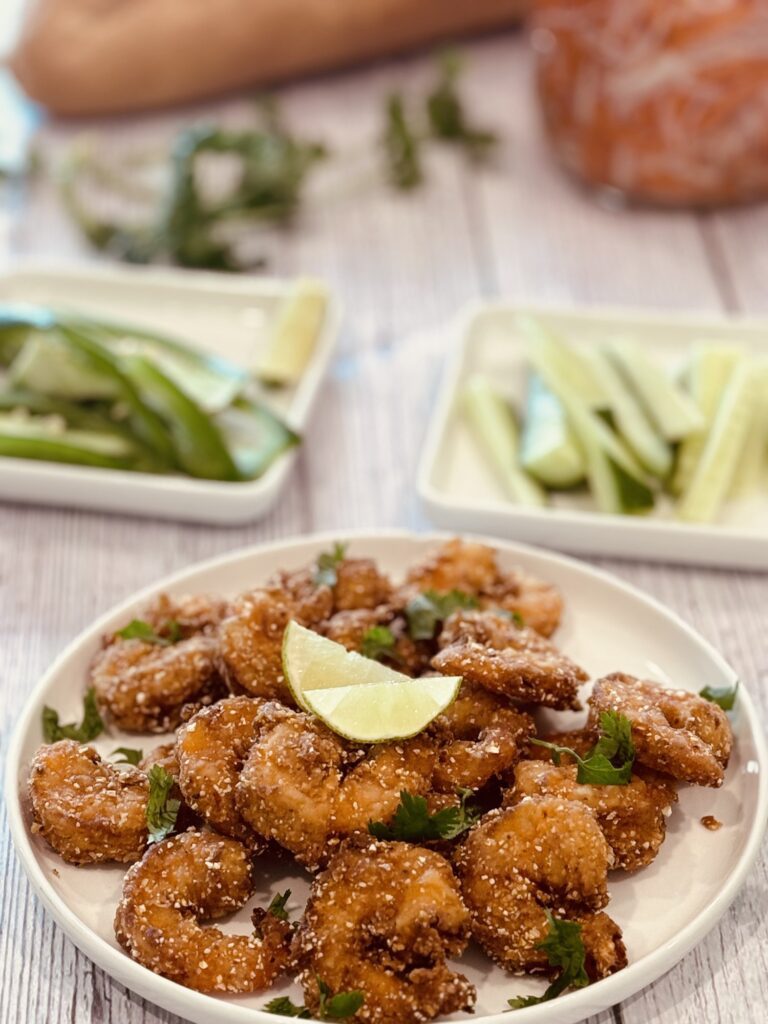
WHERE DID BANH MI COME FROM?
As with many Vietnamese dishes, the French had a big influence on the cuisine of the Vietnamese people. One of the most popular is banh mi, which is made with a baguette. During the French colonial period from 1887-1954, Vietnam was exposed to many French ingredients, such as the French baguette. These baguettes were initially filled with the most expensive cuts of meats, mainly for the wealthy, and referred to as banh tay, or “western bread.”
The French loved cured ham and pork, and cheese was imported, and then eventually produced in South Vietnam. Other European culinary influences at the time were pate chaud and jams. Flour was also imported in the mid-nineteenth century. However, both World Wars changed how baguettes, or banh mi, were made in Vietnam. Due to transportation problems with flour, the Vietnamese switched from wheat flour (banh mi literal translation is “cake/pastry + wheat”) to rice flour.
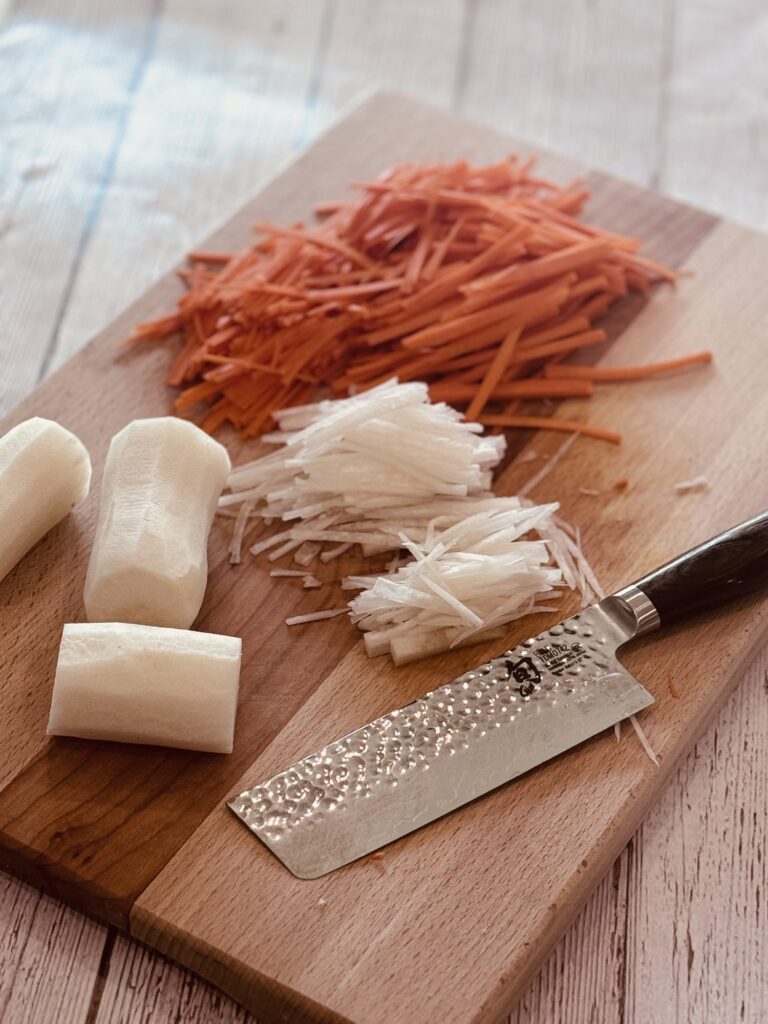
During the 1950’s mass production of the baguette, along with mass-produced cheese and meats made these ingredients readily available and at a low cost. The French pate and meats were cured with Asian seasonings and vegetables such as carrots and daikon were pickled. The Vietnamese love using fresh cucumbers and coriander in their cooking as well, all leading to the birth of the banh mi.
It is believed that the first banh mi was created in a sandwich shop in Hoa Ma, in 1958. The couple that ran the shop immigrated to Saigon in 1954 and named their shop after their village outside of Hanoi. They wanted to create a convenient on-the-go food using fresh ingredients, but make it more affordable. District 3, the name of the shop, is still open today and run by the same family.
MODERN BANH MI
I recently glanced at Dong Phoung’s banh mi menu recently and was very pleased how many different variations have been added. There is now an Impossible Bulgogi, Vegetarian Jambon, Toasted Shrimp Patty, Toasted Fish Patty, Rotisserie Chicken, BBQ Chicken, and Impossible Meatball on the menu. It’s good to see how the banh mi have been adapted to modern times and tastes.
This Sticky Fried Shrimp Banh Mi recipe is a fusion of Vietnamese and local New Orleans cuisine. New Orleans created the po boy sandwich, which is similar to the banh mi. Po boys are usually dressed with fried shrimp, oysters, or roast beef. This recipe celebrates both culture that’s had a big impact to me.
WHAT’S IN A BANH MI?
The formula for a Vietnamese banh mi is simple: a warm crusty bread, a filling consisting of cold cuts or grilled meats or any protein of choice, pickled vegetables, an aioli or spread, and condiments to taste. Let’s break down each component.
Bread
For me, this is the most important component, a good crusty baguette. It should feel light, has a thin crust, possesses an airy, cottony interior, tastes faintly sweet, and is affordable. The best banh mi isn’t fancy or rustic. You also don’t want it to be too rustic and hard, as it will scrape the roof of your mouth, muting the ingredients inside, and not be pleasant.
As mentioned earlier, banh mi was eventually made with rice flour instead of wheat, but nowadays, you will find a combination of wheat and rice is used. The rice flour adds a bit of crusty and airy texture, but if too much is used, the bread does not brown well. Also, without gluten, bread with lots of rice flour does not rise well and is dense. I’ve found most bakeries use about 2 tablespoons of rice flour in their recipe. Just keep in mind, the bread does not have to have rice flour to be a true Vietnamese-style baguette for banh mi.
If you cannot find the bread and or short on time, try French baguettes, Mexican bolillo or telera rolls, cubano rolls, ciabatta rolls, hoagie or cheesesteak rolls, or even mini slider buns.
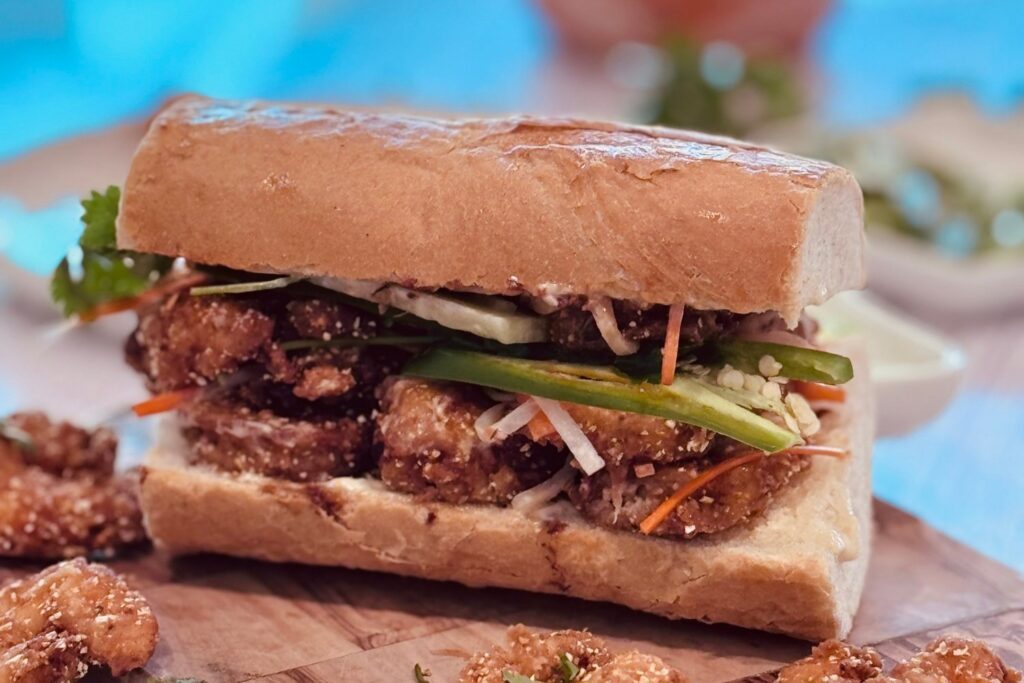
Tips for Buying Bread for Banh Mi
- While a baguette is most frequently used, you can try sliced bread as long as the outside is crispy and the inside is soft.
- Fresh-baked bread works the best. To rehydrate old bread, quickly run the bread under running water for 2-3 seconds. Pop it in the oven at 250° for about 10 minutes.
- Check in your ethnic grocers, bakeries, and delis for bread. Many Vietnamese banh mi shops will also sell you the bread only.
- Look for bread that feels relatively light when picked up
- Look for a soft, chewy interior. Press on the bread. It should slowly bounce back
Fillings
The possibilities are endless here. Some options are Vietnamese cold cuts or “thit nguoi”, Vietnamese smashed meatballs, pate made of pork or chicken, grilled meats like pork or chicken, or Cha Lua, a cooked pork roll lightly seasoned with fish sauce. Others to consider are lemongrass chicken, head cheese, and Vietnamese ham.
If you are a vegetarian, tofu can be used, or simply eggs or shrimp. As mentioned earlier, Dong Phuong now has an Impossible Meat on their menu. I have also seen recipes for jackfruit banh mi, which has a “meaty” texture. You can also use seafood such as shrimp or oysters. For this recipe, I will be using fried shrimp.
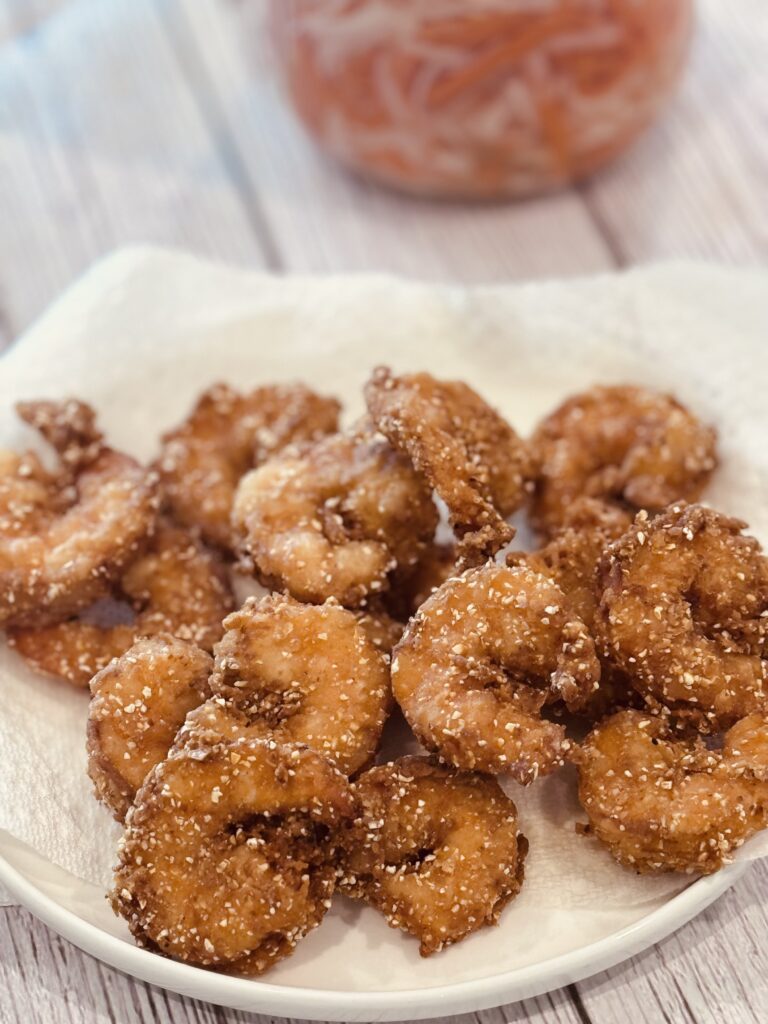
Fat
There are a few options to choose from when adding a spread to your banh mi. Mayonnaise like Kewpie can be used, as an aioli or bo, or butter. You can also use pate as your spread, which gives it an umami and savory flavor.

Vegetables
Pickled carrots and daikon are staples on banh mi, giving it its signature sweet and tangy flavor. Other vegetables are sliced cucumbers, cilantro or coriander, and jalapenos. You can also pickle the jalapenos with the carrots and daikon. Other garnishes may include mint leaves, basil leaves, or a combo of both.
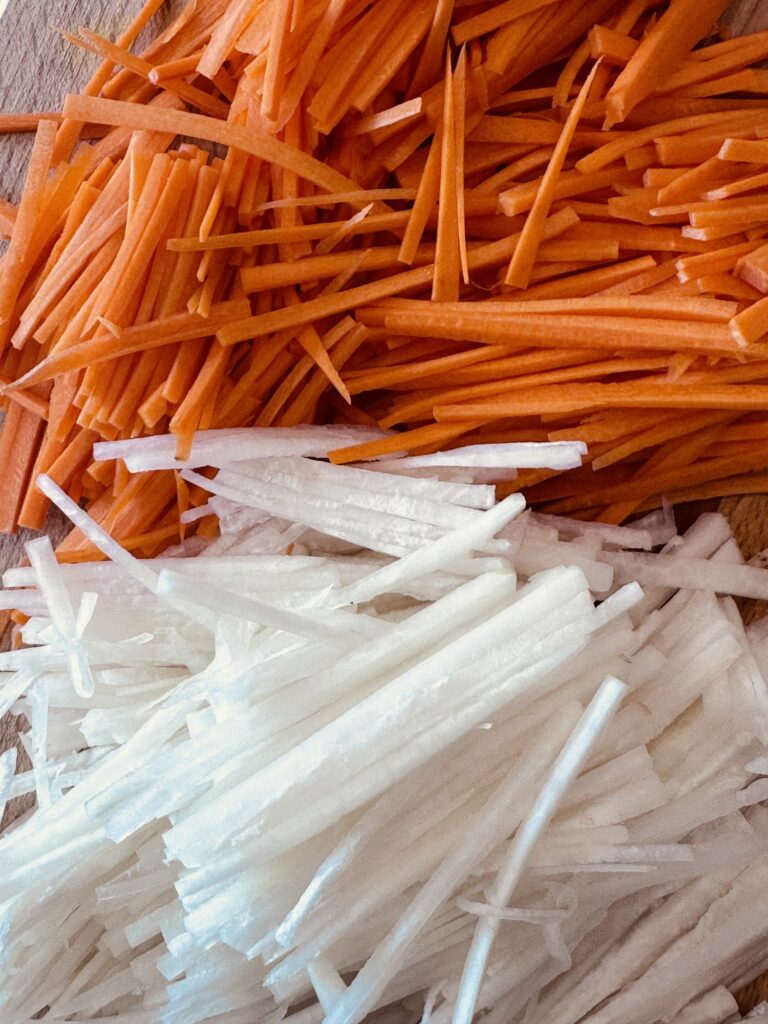
Seasoning
Maggi Seasoning is an integral part of the signature banh mi flavor. If you do not have this, soy sauce can be used. Another alternative is Bragg Liquid Aminios. For extra spiciness, I also like adding Sambal to my banh mi. Other seasonings are fish sauce, chili sauce, or chili oils.
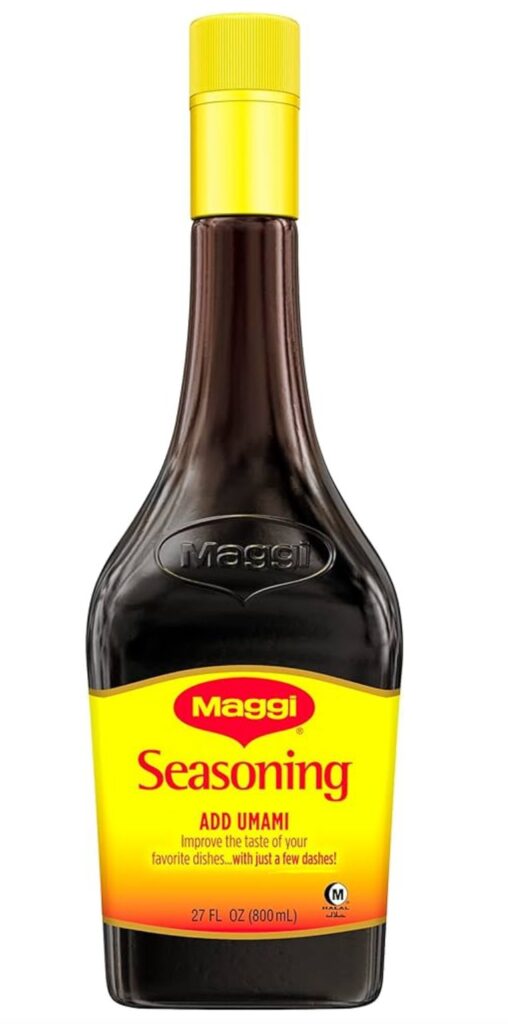
ASSEMBLE YOUR BANH MI
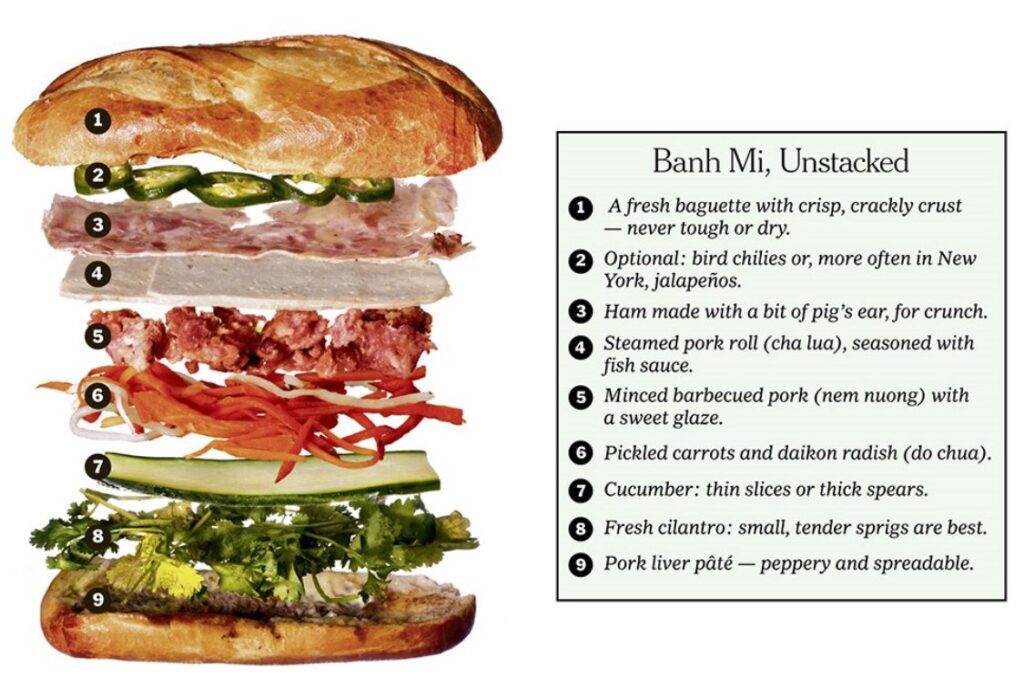
Step 1: Using a serrated knife, slit the bread lengthwise, maintaining a hinge. You may hollow out some of the inside too. make room for the filling if you choose.
Step 2: Spread your chosen fat on the two sides of the bread, covering the edge. Season by drizzling in Maggi or another liquid condiment.
Step 3: Working from the bottom up, later the filling, pickles, chile, cucumber, and herbs. Close the sandwich. Serve whole or cut in half crosswise.
THE RECIPE
Dive into the delicious worlds of Vietnamese Banh Mi and Po’ Boy sandwiches! Whether you’re a fan of the tangy fusion flavors of Banh Mi or the hearty goodness of a Po’ Boy, this Fried Shrimp Banh Mi recipe brings serious flavor to the table. The crispy baguette is loaded with fresh herbs and pickles, and the roll is overflowing with a cornmeal fried shrimp! The aioli spread gives it the perfect umami flavor to complement the shrimp.
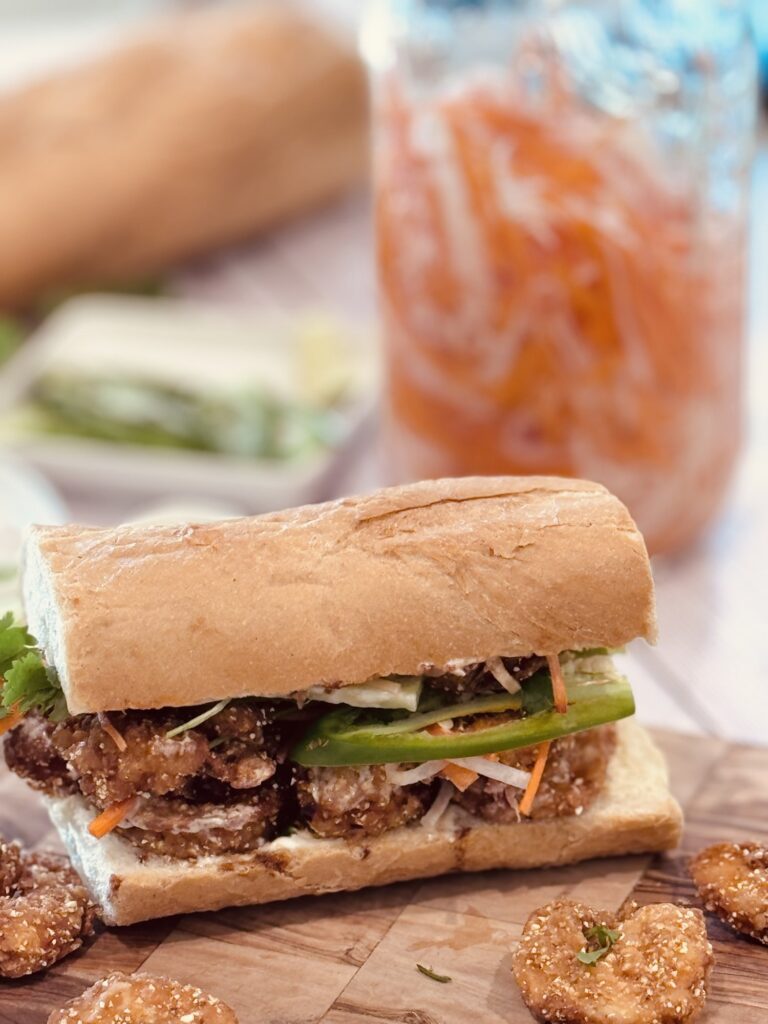
WHAT YOU WILL NEED:
Pickled Carrots and Daikon
- 1 carrot, peeled and julienned
- 1/4 daikon, peeled and julienned
- 1/4 cup granulated sugar
- 1/2 teaspoon Kosher salt
- 1/2 cup white vinegar
Fish Sauce Caramel
- 1 large garlic clove, minced
- 1/3 cup hot water
- 2/3 granulated sugar
- 1/3 cup fish sauce
- 2 teaspoons crushed red pepper flakes
Vietnamese Ailoi/Bo
- 1 cup neutral oil
- 6 large garlic clove
- 1 large egg
- 1/2 teaspoon fish sauce
- 1/4 teaspoon Kosher salt
- 2 tablespoons water
Sticky Fried Shrimp Banh Mi
- 1 cup all-purpose flour
- 3/4 cup cornmeal
- 1/2 teaspoon Kosher salt
- 1 large egg, beaten
- 1/2 cup whole milk
- 2 pounds medium shrimp, peeled and deveined
- Neutral oil for frying
- 4 Banh Mi bread or any light, crusty loves or bread
- Vietnamese Aioli to taste
- Fish sauce caramel to taste
- 1 lime, quartered
- Pickled Carrot and Daikon
- 1 English cucumber, cut lengthwise into strips
- 1/2 cup cilantro, roughly chopped
- 2 jalapeno, sliced
- Maggi Seasoning or soy sauce to serve
- Sambal or Crystal hot sauce to serve
Pickled Carrots and Daikon
Step 1: Place the carrots and daikon in a bowl. In a small saucepan set over high heat, add sugar, salt, and 1/2 cup water.
Step 2: Bring to a boil, then add vinegar. Pour this brine over the bowl of vegetables, toss to combine, and let cool at room temperature. Refrigerate until ready to use.
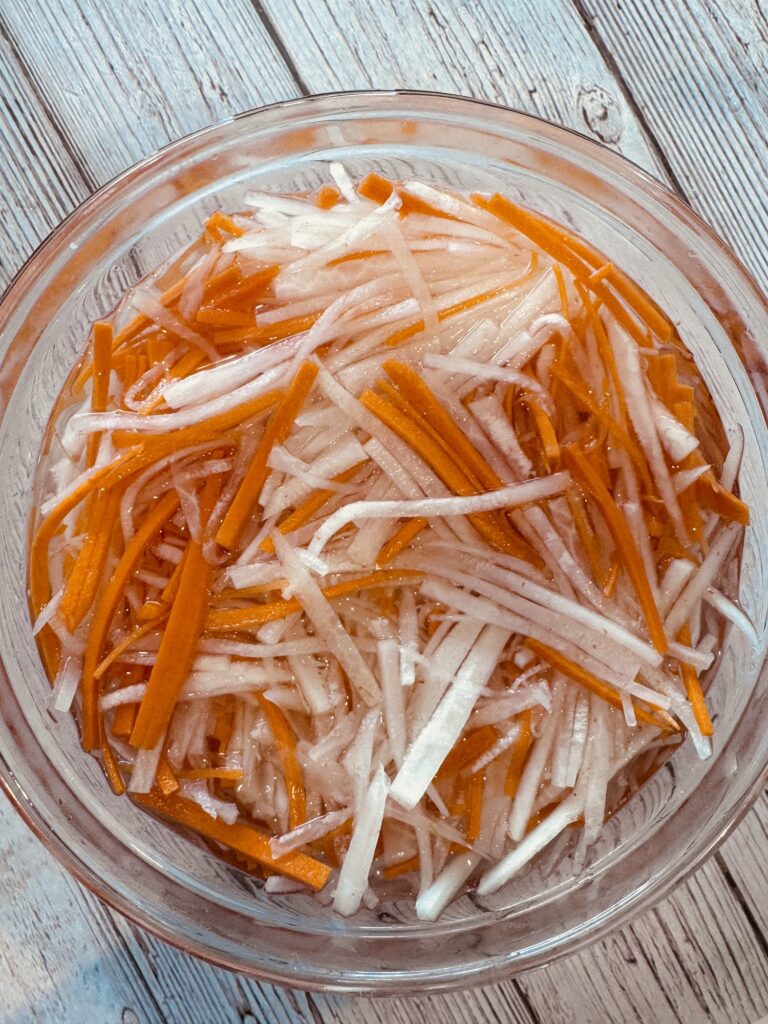
Fish Sauce Caramel
Step 1: In a small bowl, add the minced garlic to 1/3 cup of hot water. Let it soak for 5 minutes.
Step 2: Heat a small stainless-steel saucepan over high heat and add the sugar. Let it melt and start to turn a faint amber color around the edges, around 30 seconds. Just be careful not to let it burn. You can swirl the pan a bit to help move the sugar around but don’t stir it, which will cause crystallization.
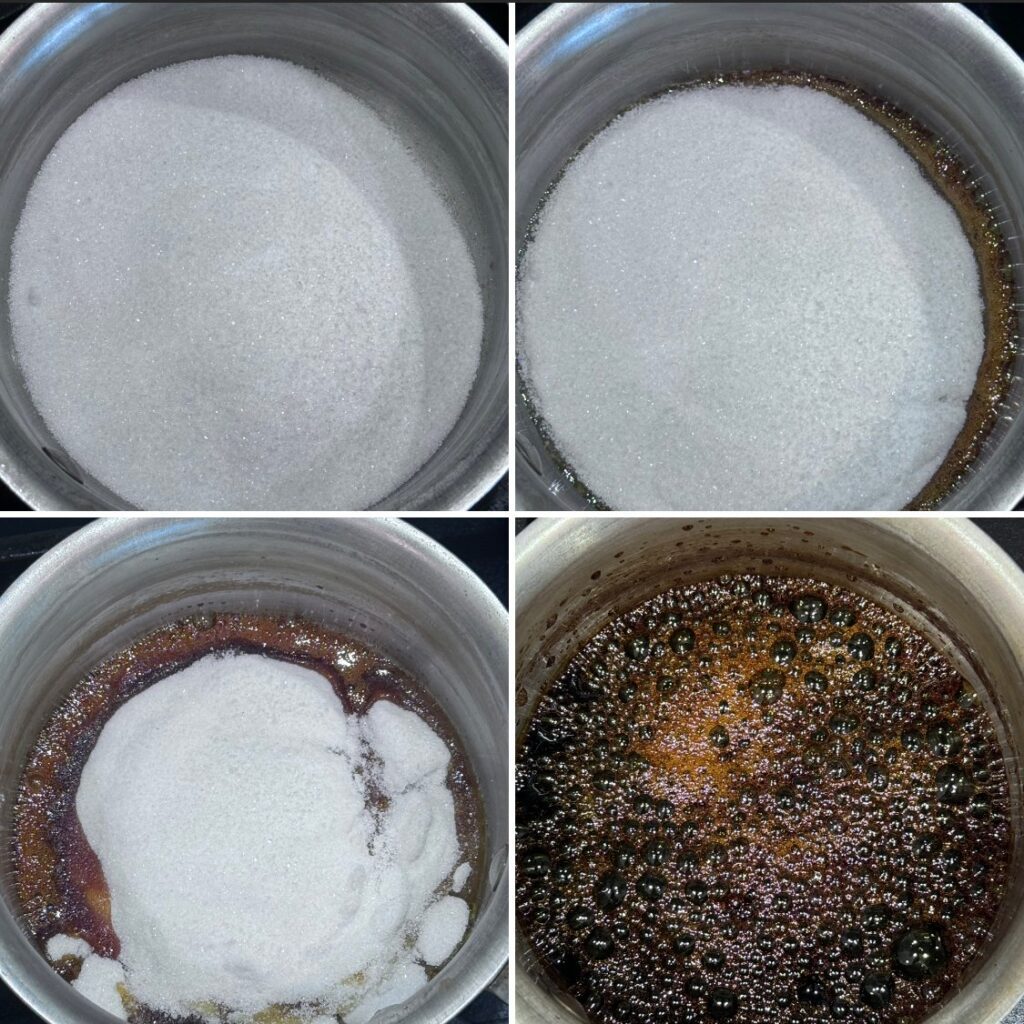
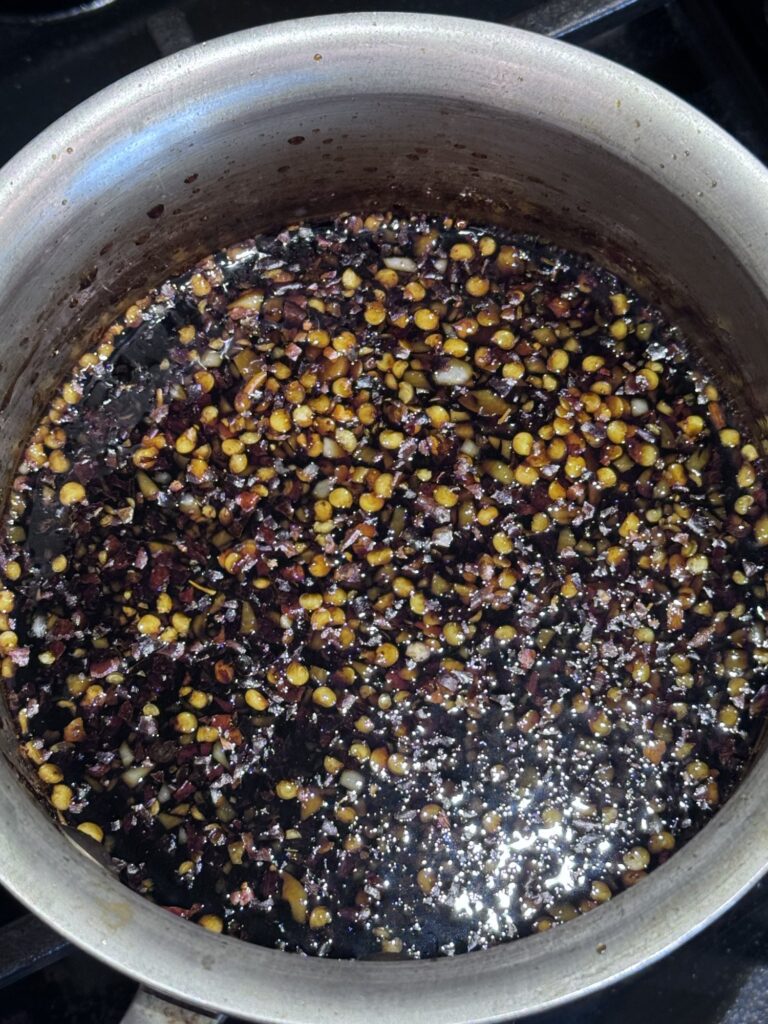
Step 3: Once the sugar is melted and just starting to turn color, remove it from the heat and add the garlic-water mixture, fish sauce, and red pepper flakes. Stir to combine. Place back over high heat and bring the mixture to a boil, stirring constantly, until all sugar is dissolved, about 3 minutes. If any major clumps of sugar remain, remove them with a spoon.
Step 4: Remove from the heat and let cool to room temperature before using. Store any leftover caramel in an airtight container in the fridge for up to 2 months. Just microwave it for about 10 seconds to loosen it or stir in 1 tablespoon of hot water at a time until you have achieved your desired consistency.
Vietnamese Aioli/Bo
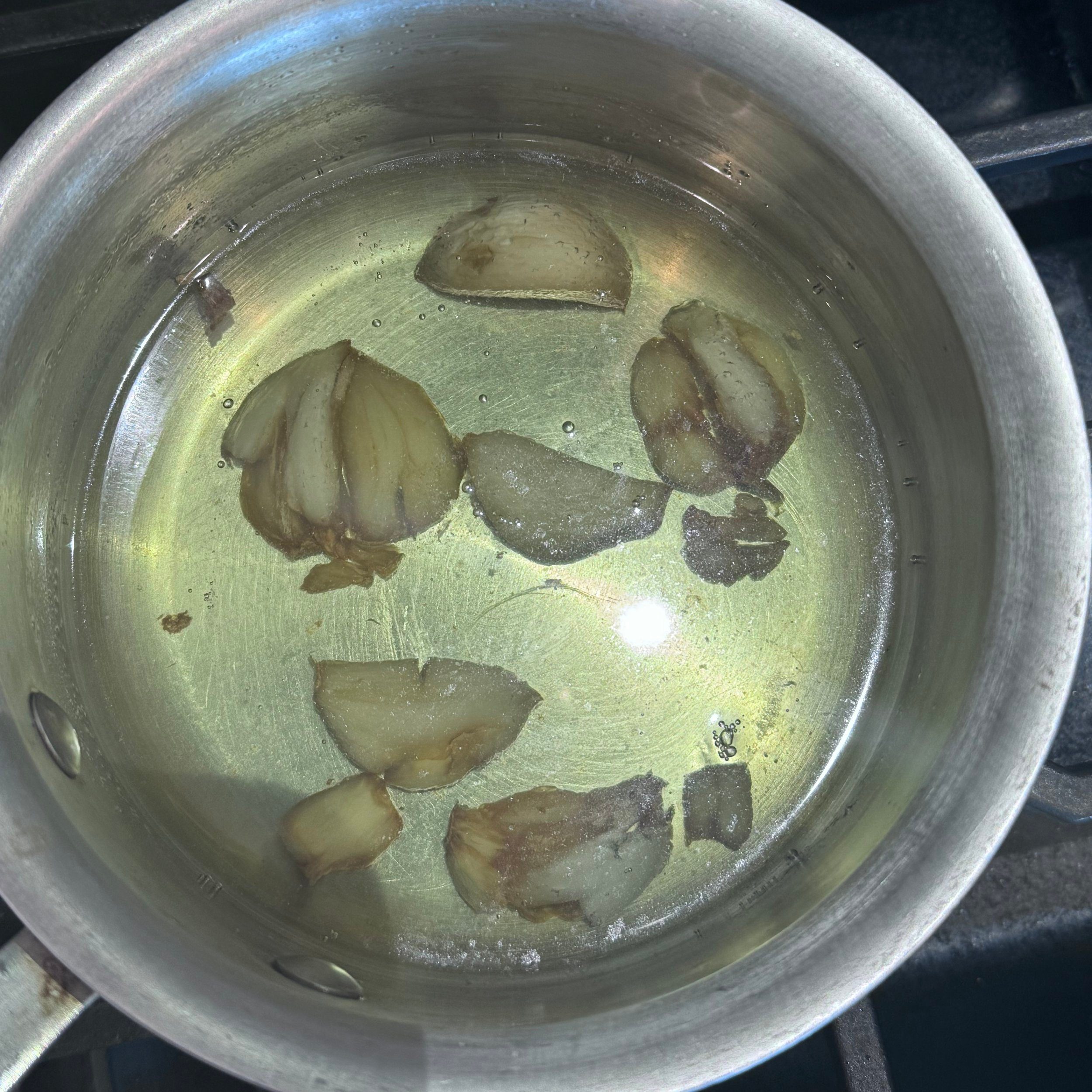
Step 1: In a small saucepan, bring the garlic and oil to a boil, then turn the heat to low, and cook for 5 minutes, until the garlic is lightly browned. Turn off the heat and set aside. Remove the garlic to a plate.
Step 2: In a large bowl of the food processor, add the egg, garlic, fish sauce, salt, and water.
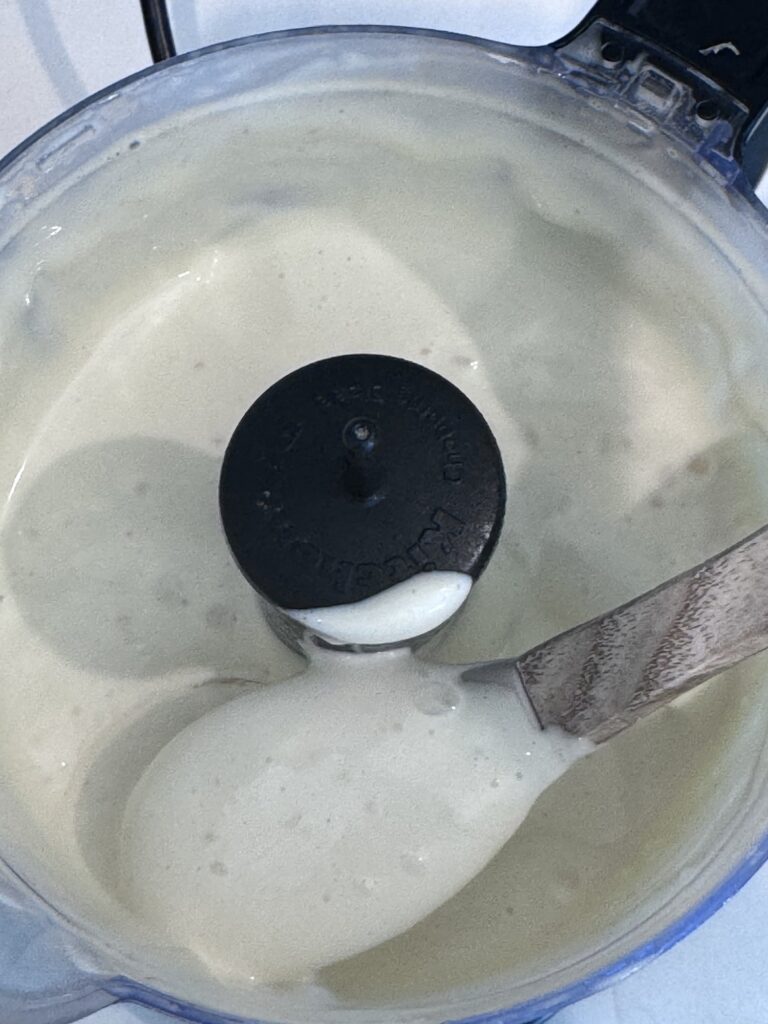
Step 3: Pulse to combine, then slowly pour in the garlic oil in a steady stream, blending as you go, until all of the oil gets incorporated, and the aioli is emulsified and creamy. Store in an airtight container in the fridge for up to 5 days.
Sticky Fried Shrimp Banh M
Step 1: In a large bowl, whisk together the flour, cornmeal, and salt. In another medium bowl, combine the egg with the milk, then add all of the shrimp.
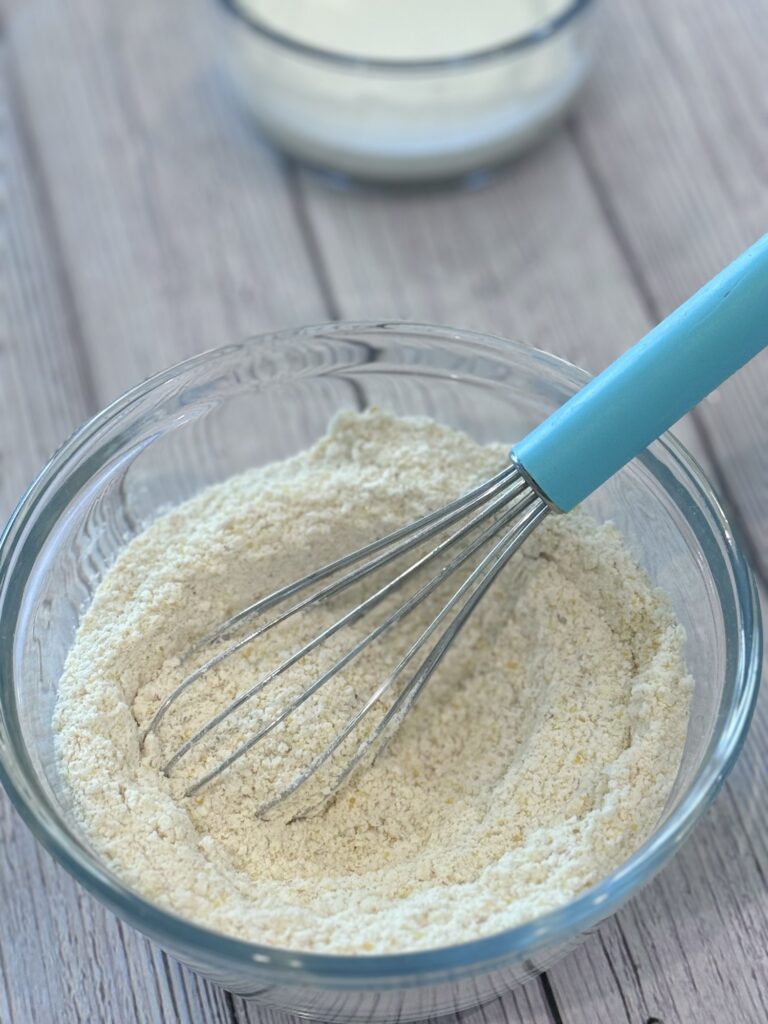
Step 2: Working in batches, remove the shrimp from the milk mixture, let the excess drip off, and add the shrimp to the bowl with the flour mixture. Toss to coat. Place the shrimp on a plate, and let sit for about 10 minutes, to allow the breading to dry.
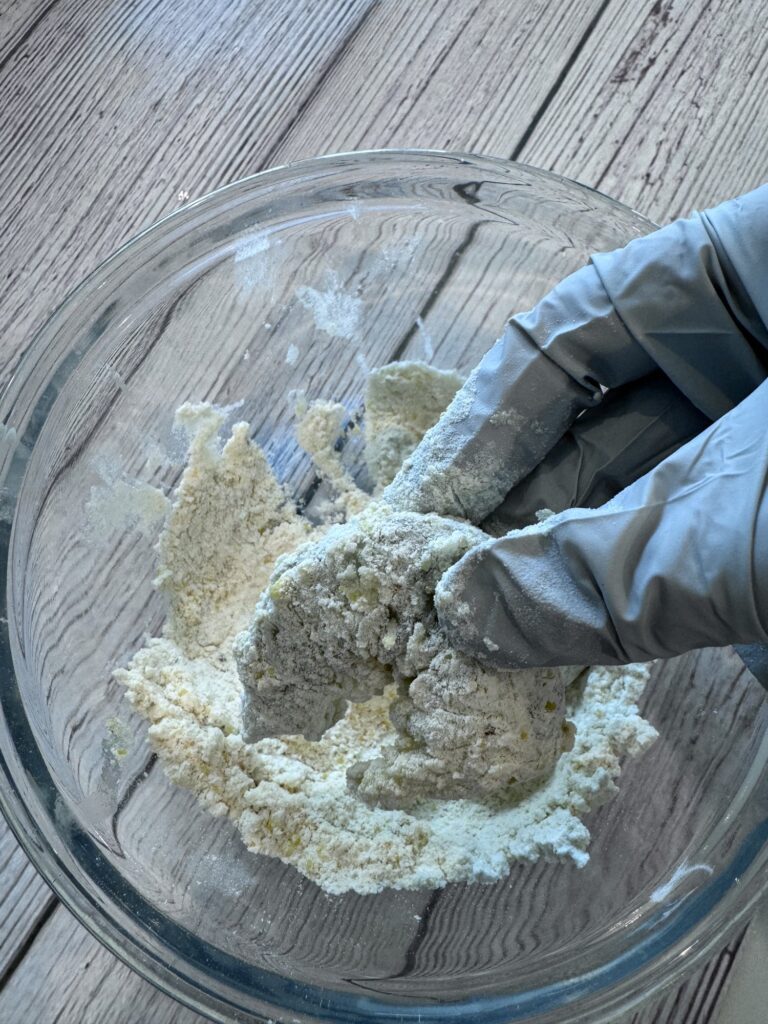
Step 3: When ready to fry the shrimp, fill a medium-sized pot with about 2 inches of oil, and heat to 360°. Working in batches, add the shrimp to the oil and fry for 2-3 minutes, or until golden brown. Remove to a plate lined with a paper towel to drain.
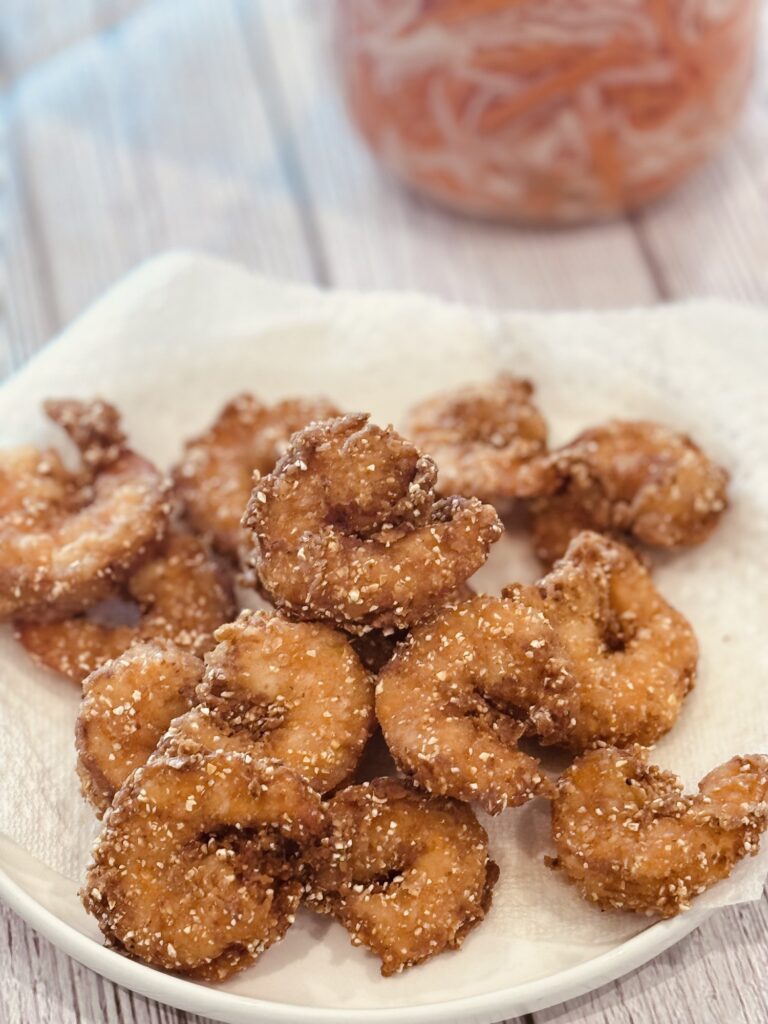
Step 4: Toast the bread and cut it in half lengthwise. Spread the aioli on both sides of the bread.
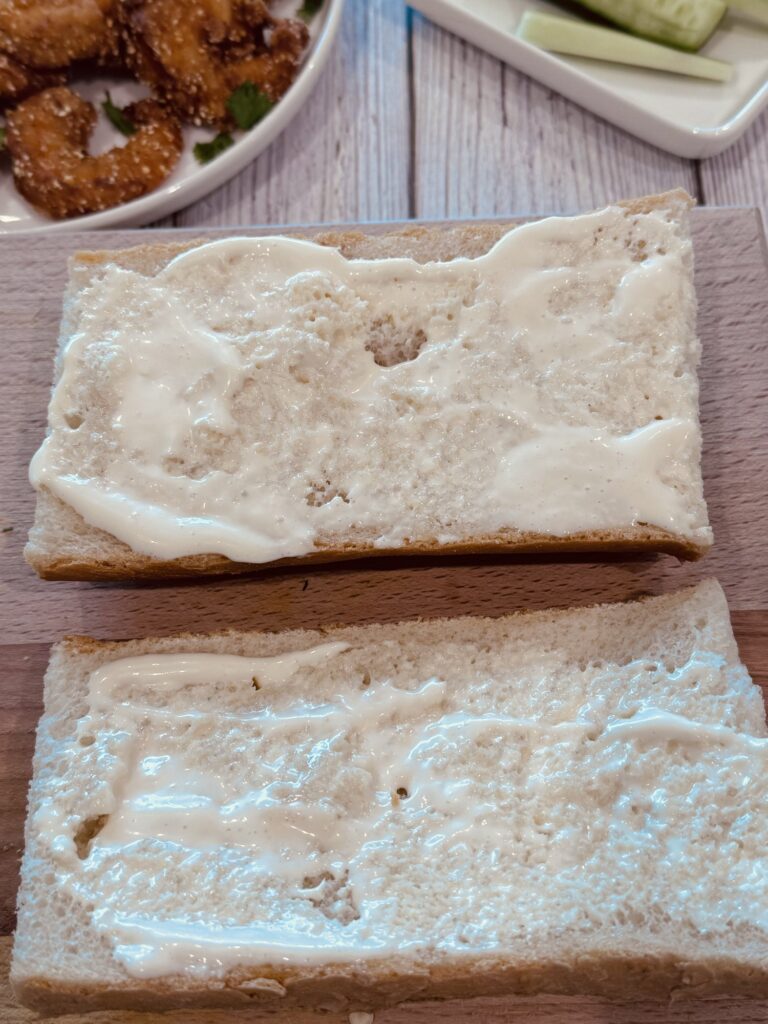
Step 5: Top with shrimp, drizzle with Fish Sauce Caramel, and spritz with lime juice.
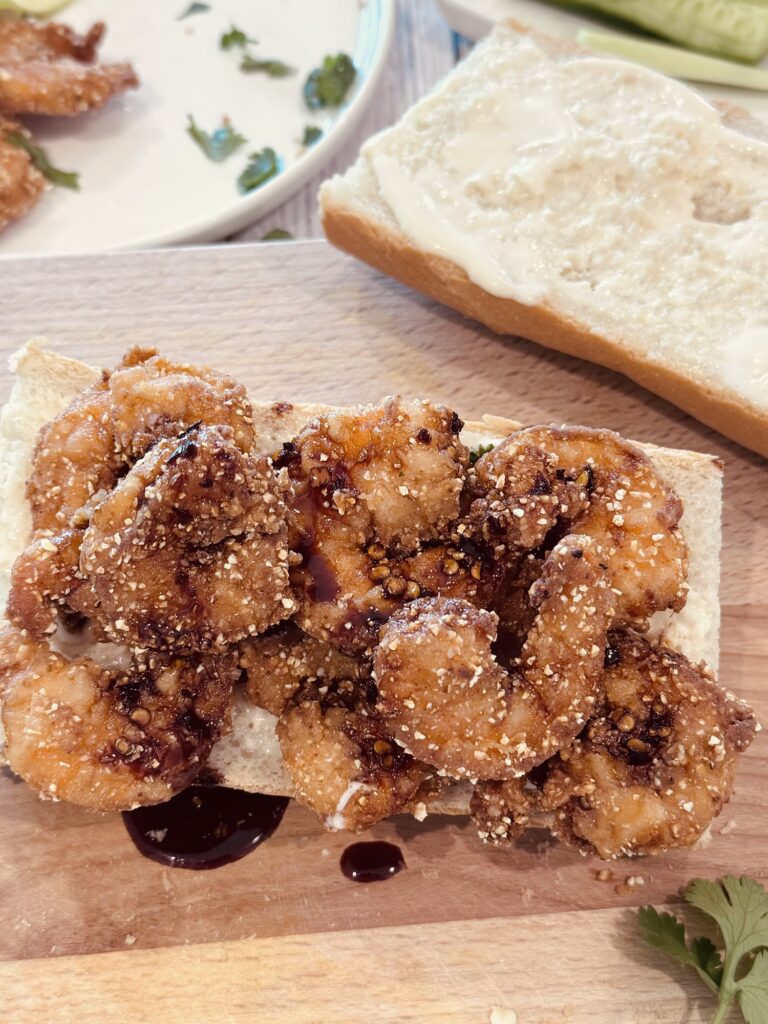
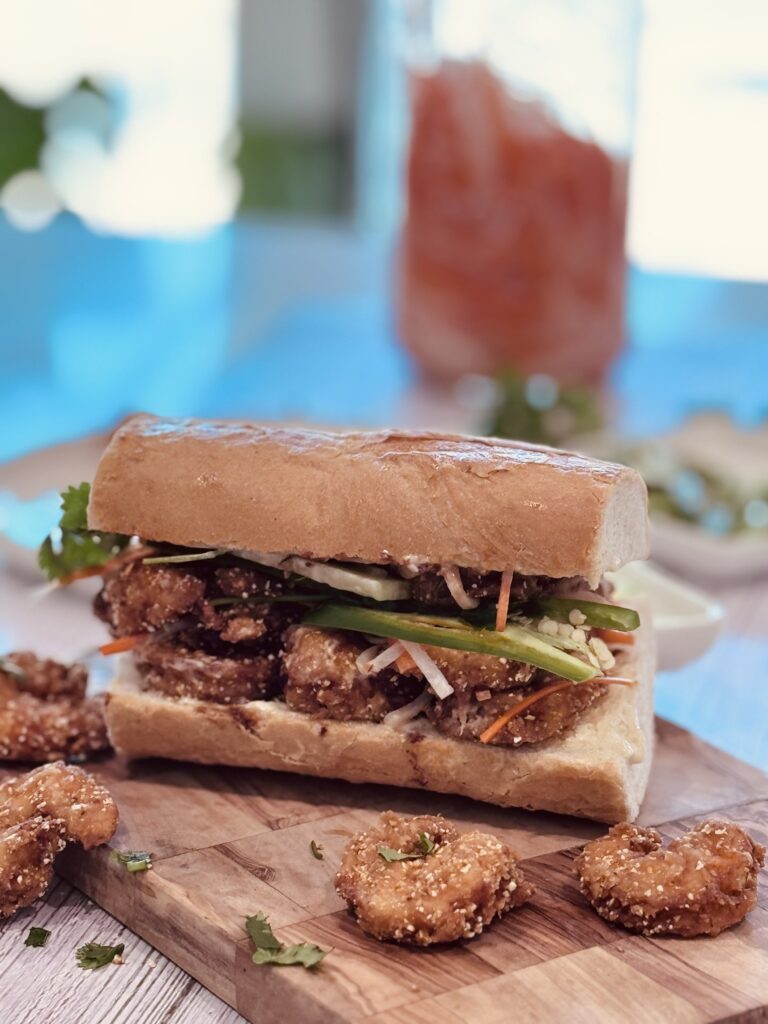
✅ Quick Tips: Read the recipe in its entirety before you start cooking. This will help you understand the ingredients, steps, and timing involved, and allow you to prepare any necessary equipment or ingredients beforehand.

Banh Mi (Vietnamese Sandwich)
Ingredients
Pickled Carrots and Daikon
Fish Sauce Caramel
Vietnamese Aioli/Bo
Sticky Fried Shrimp Banh Mi
Nutritional Value
Nutritional Value
Servings 4
- Amount Per Serving
- Calories 1283kcal
- % Daily Value *
- Total Fat 64g99%
- Saturated Fat 6g30%
- Trans Fat 0.2g
- Cholesterol 451mg151%
- Sodium 2800mg117%
- Potassium 1340mg39%
- Total Carbohydrate 119g40%
- Dietary Fiber 6g24%
- Sugars 55g
- Protein 61g122%
- Calcium 308 mg
- Iron 6 mg
* Percent Daily Values are based on a 2,000 calorie diet. Your daily value may be higher or lower depending on your calorie needs.
